Azerbaijan unmasked: Petroglyphs, temples and mud farts
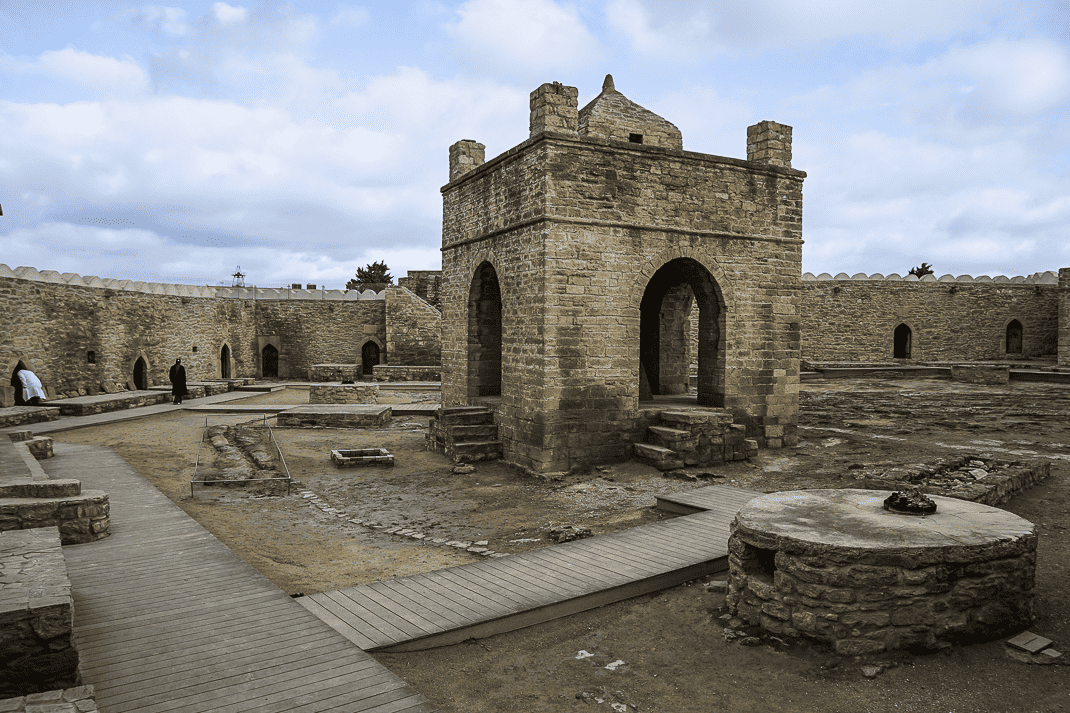
BAKU, Azerbaijan – I recently traveled through 26,000 years of Azerbaijan’s history. You can do that here. In an hour’s drive I went from staring up at the Flaming Towers, where nightly light shows made me feel like I crawled out of a Vegas casino at dawn, to a pile of rocks with carved drawings of bulls and pregnant women.
In between, I saw what Azerbaijan has gone through and what led it to what it is today: one of the world’s architectural wonders and a hot destination on the tourism scene. But I also saw a side of Azerbaijan that most tourists don’t see, the side which tells me the country still has a ways to go to become more than a cute Instagram clip.
Marina and I took a very cold day trip to four points of interest outside the capital of Baku: Qobustan, where Azerbaijan’s earliest man left his artistic renderings all over boulders and cliffs; Daskil Hill, where a series of little mud volcanoes offer visitors a somewhat disgusting and very disappointing site to forget; Fire Temple, an example of two religions living peacefully together centuries before religion tore this region apart for decades; and Fire Mountain, where Azerbaijan’s plethora of gas reserves bubbles out of a suburban mountain into a perpetual public flame.
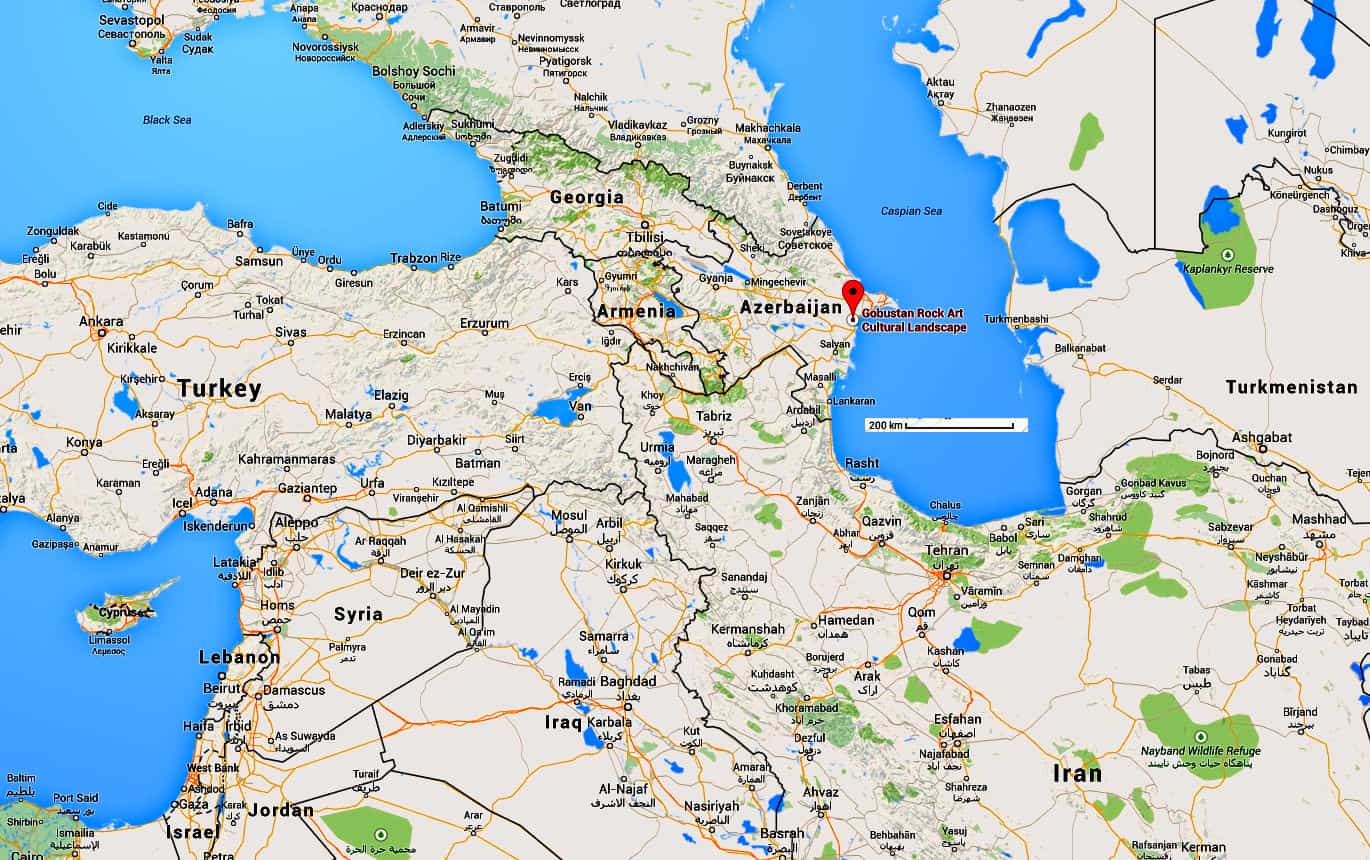
It wasn’t exactly a trip to Versailles, but I like getting out of cities. We met our guide, Samir, at the Double Gates, two massive, arched entryways that have led visitors into Baku’s Old City since the 12th century. We had gone there the day before to sign up for the tour with one of the numerous agencies, many of which had barkers pouncing on us as soon as we entered the gates.
You know a country has entered tourism’s mainstream when you have to pass a gauntlet of men holding up brochures to get your morning coffee.
Samir has had a rough life. An electrical engineer in the old Soviet Army. He spent 12 years offshore on oil rigs and had two heart surgeries and a divorce. I don’t think I saw him all day without a cigarette in his hand.

Every day under the Soviet Union showed in his creviced face and gray hair. At 62, he was five years younger than me. He looked like my father.
But like many Azerbaijans, he’s full of pride for what his country has built. A wealth of information, he made the drive around the peninsula sticking into the Caspian Sea even more interesting than the sites.
As our van carrying us and a middle-aged Lithuanian gentleman fought traffic getting out of Baku and drove along the southern shore, I immediately asked him about the war with Armenia. After Azerbaijan’s victory in September, president Ilham Aliyev went into Stepanakert, the capital of Nagorno-Karabakh which Azerbaijan had just taken back, and threw a damn parade.
Aliyev high stepped all the way to last Wednesday’s election where he won a fifth term with 92 percent of the vote.
“He’s a winner,” Samir said, “but 20 years maybe is enough.”

Samir pointed to offshore tankers collecting some of the oil reserves that make up 90 percent of Azerbaijan’s exports and have made it one of the wealthiest of the former Soviet republics. Then we cut inland past a big muddy field. A black derrick, bobbed up and down like a giant, thirsty bird.
Oil fields are gross. They’re dirty. They’re ugly. They’re boring. The massive spread of oil derricks I once saw in Odessa, Texas, permanently stamped Odessa in my mind as one of the world’s ugliest towns. But this derrick outside Baku was history.
It was the world’s first oil field, dating back to 1848 when Azerbaijan supplied half of Russia’s oil.
We passed more derricks and I realized I had seen more oil wells in Azerbaijan than mosques. Samir said between puffs that Baku, the capital of 2.5 million people, only has 10. Istanbul has 3,000. Samir said Josef Stalin destroyed the rest.
However, it also reflects how little effect religion has on Azerbaijan. Besides only 1 percent of all Azerbajainis go to a mosque at least once a week, Azerbaijan remains the closest Muslim country to Israel.
Oh, yes. We must try Azerbaijan caviar. It comes from the sturgeon in the Caspian Sea, which he calls the world’s biggest lake, measuring 2,000 kilometers across and bordering five countries, from Iran to Russia.
Soon we were at our first site.

Qobustan Petroglyph Reserve
We pulled through a guarded gate with “QOBUSTAN” emblazoned on a sign above it. Up the hill we saw a cavalcade of yellow limestone, from boulders to huge cliffs, folding along the landscape. The high walls did little to protect us from the cold which had dropped to 37 degrees (3 celsius) with a wicked wind flying up from the Caspian.
It was here, 26,000 years ago at the end of the Ice Age that early homosapiens carved out a life. In 1968 UNESCO made Qobustan a World Heritage Site for its well-preserved petroglyphs. Samir led us up the rocky path to rocks with clearly drawn animals. Two bulls. Horses. A pig. A dog. A camel.
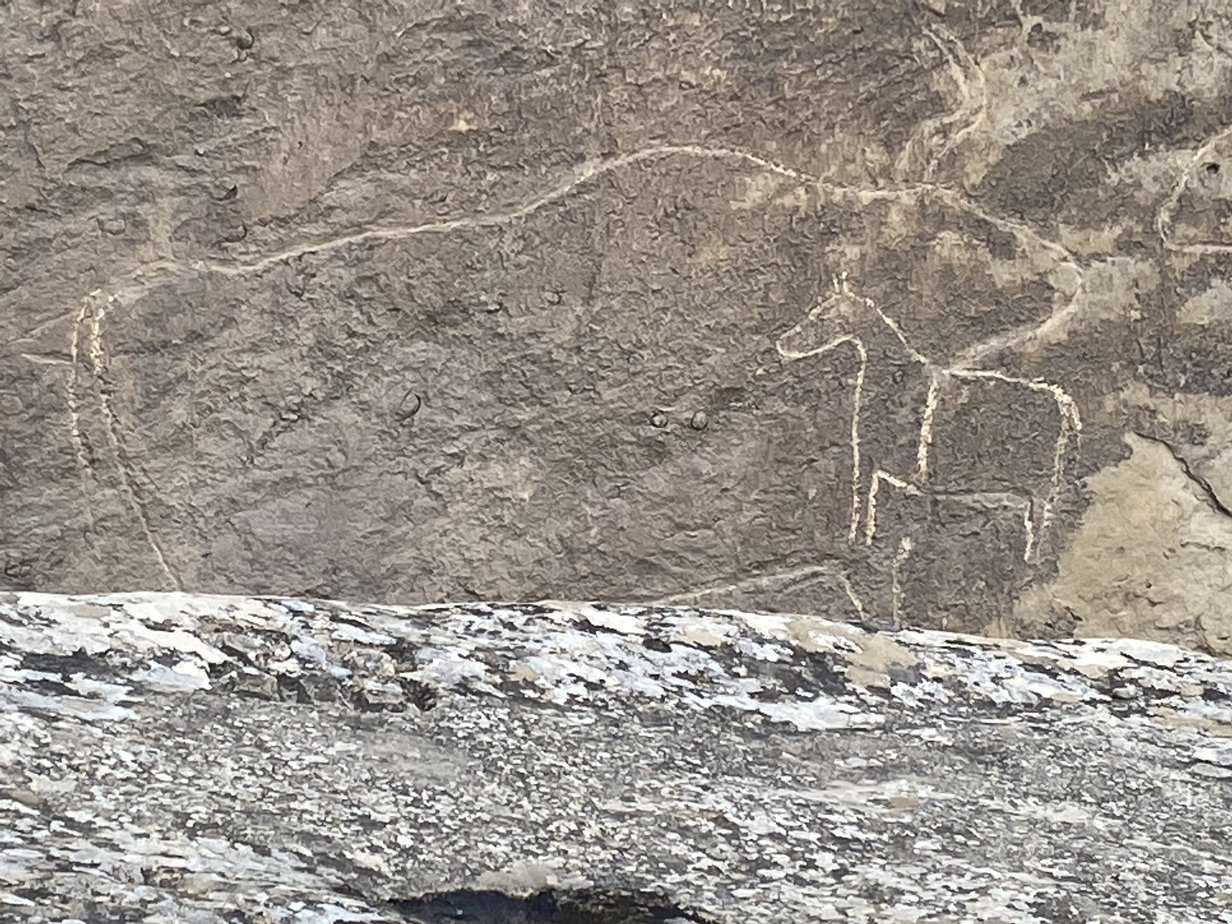
He pointed out one rock showing a pregnant woman, a drawing he estimated at 12,000 years old.
Samir said five million years ago, the sea came up to this point. He pointed to the top of the cliff and said all this up to there was under water. Off in the distance we could see the oil derricks, looking little like crows, bobbing up and down in front of the sea.
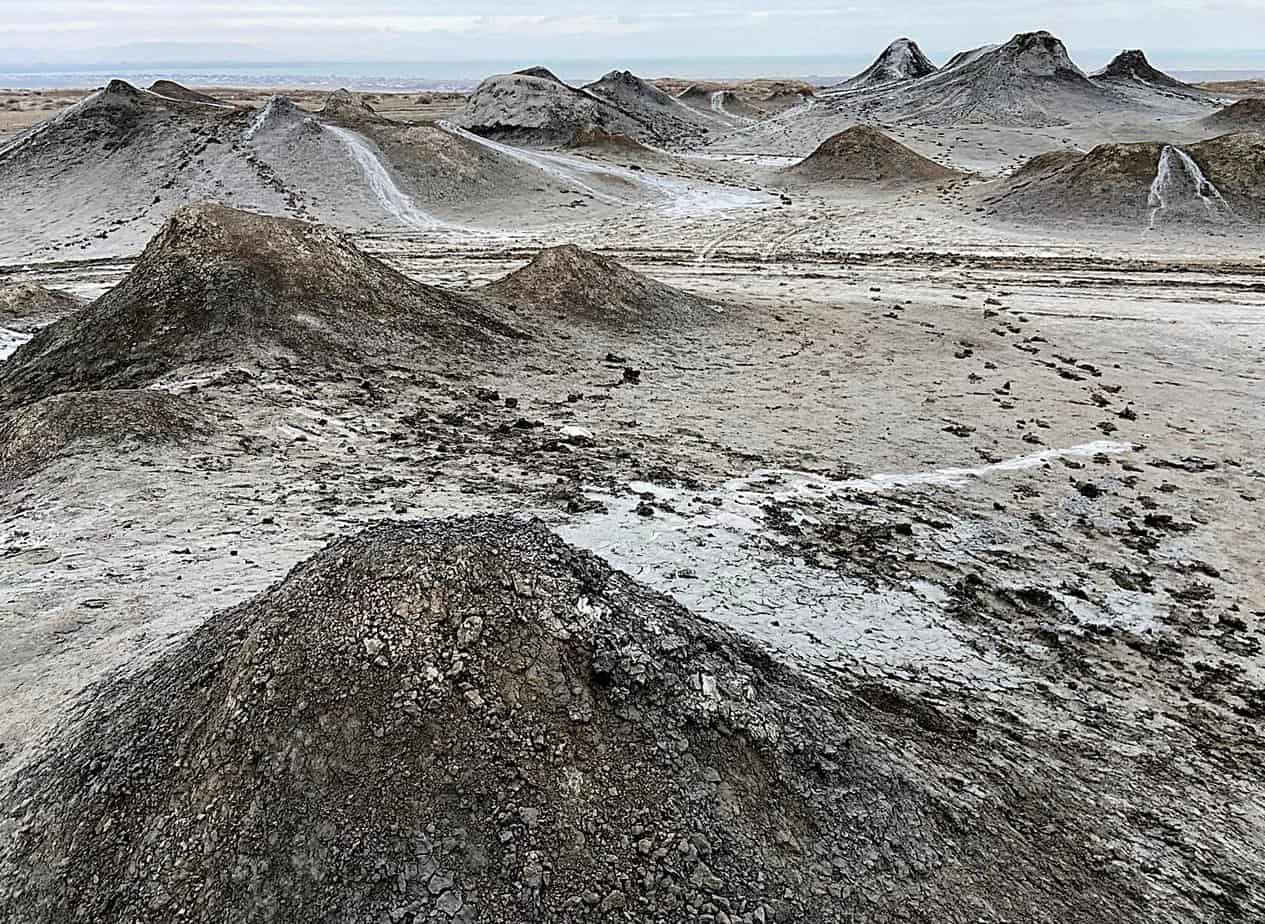
Mud Volcanoes
These are on the must-see list of any Azerbaijan guidebook or Internet website. These guidebooks and Internet websites are proof that you can not believe everything you read. In 46 years of international travel, these Mud Volcanoes rank up there with Cancun and foie gras among the biggest disappointments.
We descended from Qobustan to the main road where we switched to a four-wheel-drive vehicle. We entered a giant landscape of mudflats for six miles (10 kilometers) before we stopped at a little rise.
We walked precariously across the mud, not knowing when our shoes and lower legs would sink into the murky path. We stopped at a little puddle. We waited. After a few seconds, the puddle burped. A little bubble formed and popped. It sounded like a geological fart.
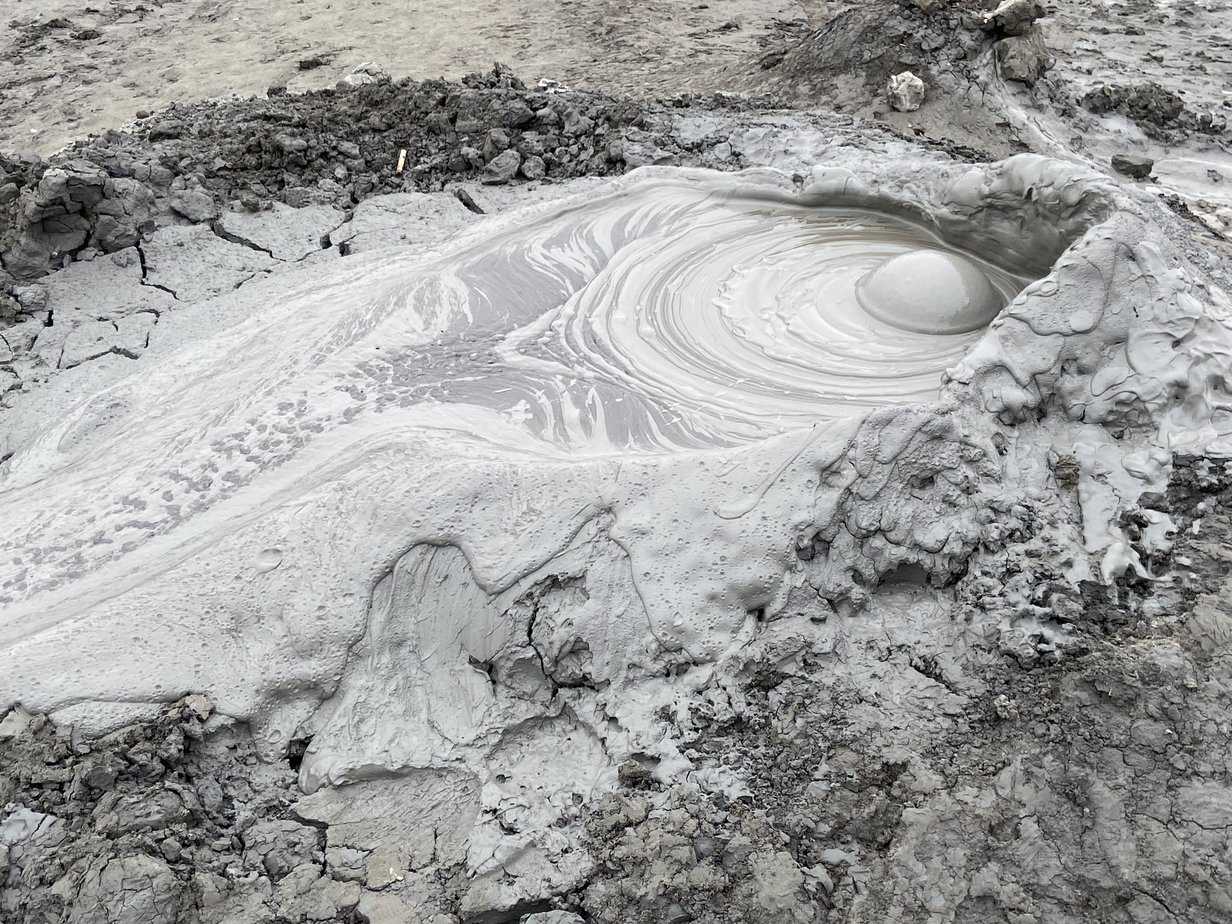
Samir said 350 volcanoes, formed 60,000 years ago, dotted the landscape, all formed by a mix of sea water, mud, clay and oil. We saw one.
What we did see was trash. Lots of it. Pieces of shopping bags were strewn all over the grounds like an army of crazed cats had torn into sheets of catnip-covered plastic. We had just left Baku, called “The Cleanest City in the World” where we feared public flogging for dropping a bottle cap. And here we were on a UNESCO World Heritage Site that could pass for last week’s homeless camp.
Samir blamed Indian tourists who have flooded into Azerbaijan ever since airlines started direct flights from Mumbai and Delhi.
Samir said to dip a finger. Cautious of the word “volcano” conjuring up images of molten lava, I inserted a finger and the mud was as cold as the air. But the mud was smooth as paint. No lumps. My finger was covered in a dark gray, thick fluid. Remembering how the little eruption sounded like a fart, I suppressed a wave of nausea and quickly headed back to the van.

Azerbaijan lunch
Lunch was a highlight. A true slice of rural Azerbaijan life, we stopped in the middle of the countryside at a sprawling dining hall called Samovar Setlari. It had huge rooms surrounded by long glass displays of ready made food. It ranged from beef pilaf, fresh fish, soups, borek (cheese pies common throughout the Caucuses), whole roast chickens, an entire table of salads, beef kabobs.
Azerbaijani rugs hung from the walls as workers from around the area poured in. I had a big cucumber salad, a chicken kabob, a borek and a Coke for only 15 manats, a little more than €8. It was one of the best food bargains in a country full of them.

Fire Temple
Zoroastrianism is a religion that came from Ancient Persia dating back to the 2nd century B.C. It’s believed it influenced Judaism, Christianity and Islam. It’s based on the overwhelming belief of good over evil, or some such nonsense. I always thought good and evil were in the eye of the beholder.
To Italians, pizza is good; pineapple on pizza is evil.
Anyway, Zoroastrians moved north to this area and were drawn to the Fire Temple in the town of Surakhany. Built in the 17th century, it’s a huge octagonal structure with a giant gazebo in the middle. The structures’ walls were lined with individual rooms where monks and other holy men lived.

Fire Temple is where Zorastrians, Hindus and Sikhs all worshipped peacefully together. In the rooms today are replicas of Sikhs in their turbans and loincloths, pilgrims talking over tea and even horses and donkeys in a room lined with hay.
The temple was abandoned in the 19th century when Indians left Azerbaijan but now it has been open as a tribute to the country’s religious tolerance. The most interesting part about the tour?
We learned musician Freddy Mercury’s parents, who were from India, were Zorastrians.
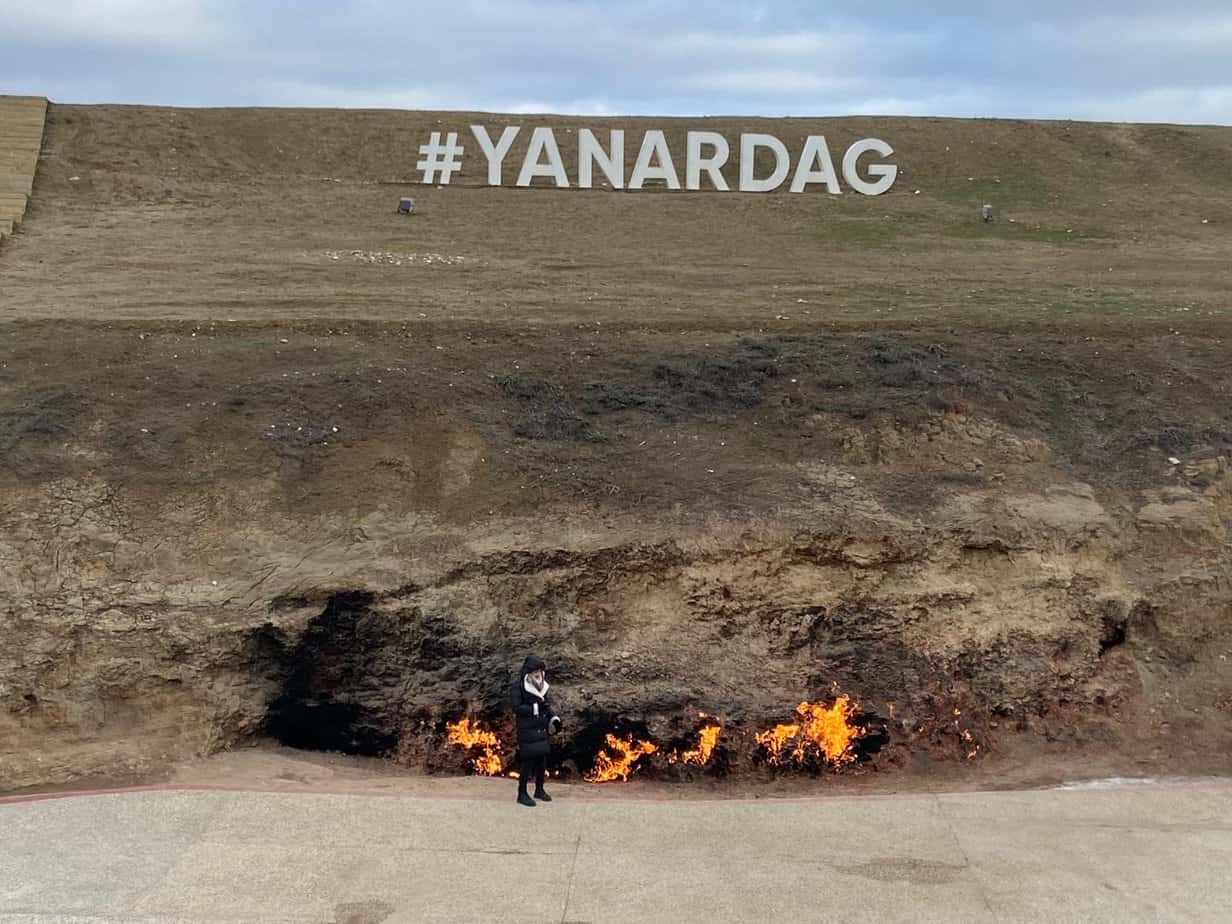
Fire Mountain
Our last stop was in the town of Yanardag where they managed to turn a little flame into a tourist trap. An entire modern amphitheater has been built around this rocky cliff where perpetual flames rise out from the base.
Samir said the natural gas underground combines with the oxygen to shoot fire from under the rocks. Nine rows of stands hold spectators who can sit there and watch flames before going to the adjacent gift shop and buy little fiery keychains.
Marina and I, along with a bevy of Indian tourists, used it to warm our hands with the temperature dropping to 30 (1-below celsius). I imagine this would not be a popular site in July when this part of Azerbaijan can reach 106.
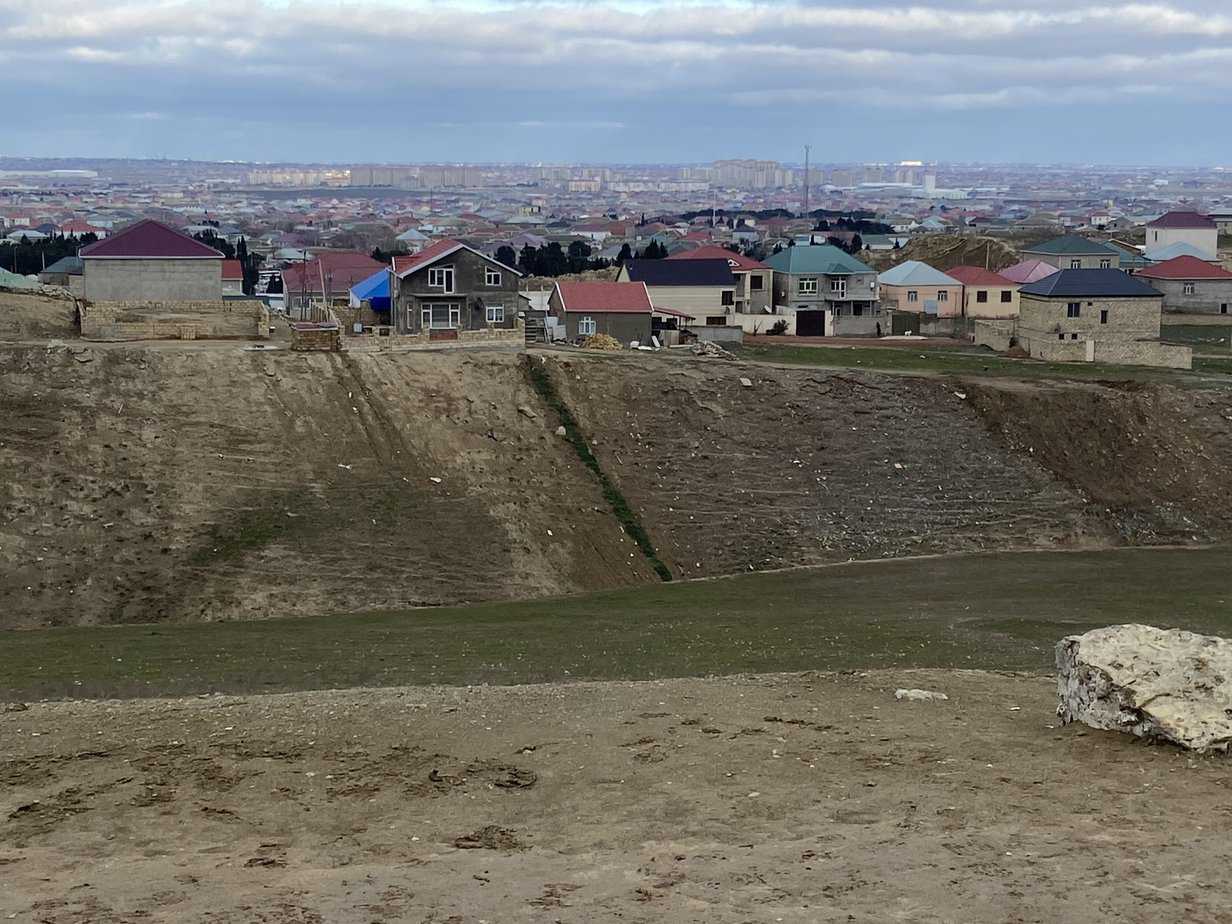
The most entertaining part was what we found climbing the man-made walkway to the top of the rocks. Below lay modern-day Yanardag. It’s typical of so much of what has happened to small Soviet towns after the fall of the USSR. With no more state funding, factories folded. The houses were run down, ramshackle with faded paint and rusted fences. Ugly apartment houses with olive green trim built by the Soviets dotted the skyline.
Off in the distance rose Baku, its glittery skyline mocking its suburban population with its wealth and promise.
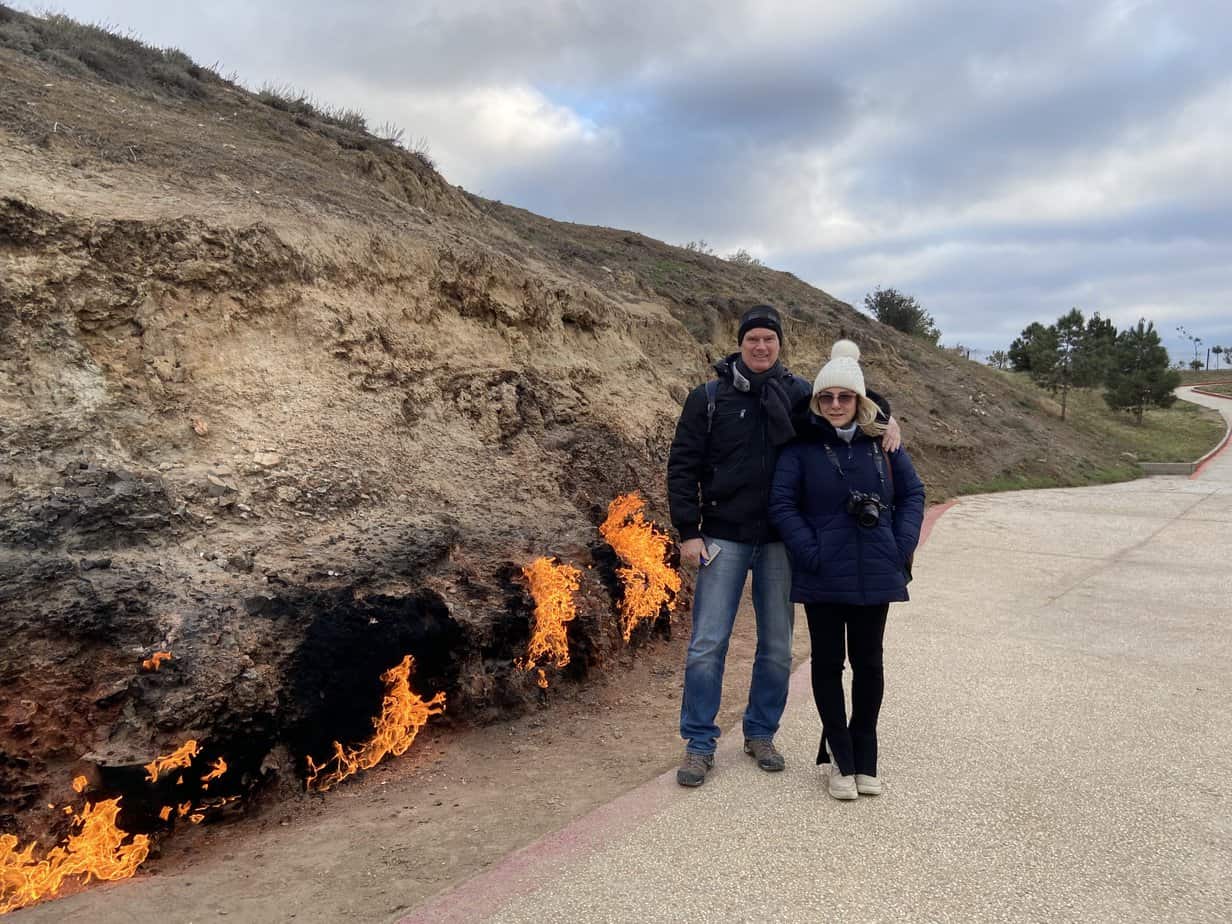
If you’re thinking of going …
How to get there: Azerbaijan Airlines, Turkish Airlines, Pegasus, Wizz Air and easyJet have flights from London to Baku. Azerbaijan flies direct. The five-hour, 30-minute flight in June is $659 round trip. WizzAir and Turkish fly with a change in Istanbul for $313.
How to get around: You can take public transport to Qobustan but it requires a change of buses and then taxis. It’s easiest to take a tour. Numerous agencies work out of the Old City. We used the locally recommended TES Tour, Sabir Str. 25, 994-12-492-5506, www.testour.az, info@testour.az. I paid €61 for two people, not including lunch.
Where to stay: Shirvanshah Hotel, 1/50 Gesr Stred Baky, 994-50-263-3837, http://rumahotels.az/home/shirvanshah/12, info@shirvanshah.az. Big rooms in the heart of Old Town, walking distance to outside the walls and to Baku Bulvar. I paid €480 for five nights. It has a spa with Jacuzzi, Turkish sauna and regular sauna. Only the sauna worked during our visit.
Where to eat: Cizz-Bizz, 28 Kichik Qala, 994-12-505-5001, 9 a.m-midnight. All the traditional Azerbaijani specialties, from kebabs to various lamb dishes. Ranges from €10-€35, 9 a.m.-midnight.
Qayana, Kicik Qala 126, 994-70-434-0013, www.facebook.comqaynanarestaurant, 8 a.m.-11:30 p.m. “Mother-in-law” in Azerbaijani, Qayana is right inside the Dual Gates and is always packed. Beautiful rugs hang from the ceilings and pickle jars oddly fill shelves. Specilizes in Azerbaijani cuisine. Try the tursha govurma, a bed of rice cooked inside bread crust then topped with lamb, chestnuts, plums, onions and spices. Mains start at about €7.
Time to go: Avoid July and August. At 28 meters below sea level, Baku is the largest city below sea level in the world. In summer it is steaming. In spring, average highs range from 62-82 with lows 46-65. Last week it ranged from high 30s and low 40s at night to about 50 during day.
For more information: Tourist Information Center, 14 Bulbul Ave., 994-12-498-1244, 9 a.m.-6 p.m. Monday-Friday.

